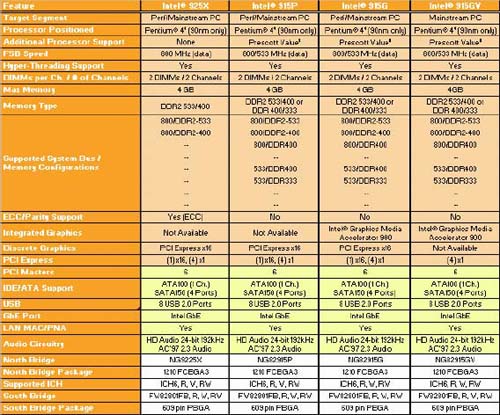
Original Link: https://www.anandtech.com/show/1358
Intel 925X/915: Chipset Performance & DDR2
by Wesley Fink on June 19, 2004 3:01 AM EST- Posted in
- CPUs
Index
The introduction of new processors from Intel is always a media event, but the launch of new Intel chipsets becomes a major event. As the largest player in the chipset market, the innovations in Intel's new chipsets always have a profound influence, not just on the Pentium 4 processor market, but on the VIA, nVidia, SiS, and other designs for both Intel and AMD Processors. Intel is more than the largest maker of chipsets, they are also the yardstick by which every other chipset and chipset maker is measured.With the introduction of the Enthusiast 925X chipset, known as Alderwood during development, and the Mainstream 915 chipset, known as Grantsdale, Intel has raised the stakes even more than usual. Not only are we seeing new chipsets, but attached are a new CPU socket 775 called Socket T, a new bus Technology called PCI Express, a new Graphics Card slot called x16 PCIe, and a new memory technology called DDR2. Those are just the highlights, since we are also seeing additional changes attached to these technologies - like new heatsinks, new power supplies, High-Definition audio, and Matrix Raid. The last time Intel attempted such a wholesale change in PC architecture was the introduction of Pentium 4 and Rambus memory. History showed Rambus to be a failure in the market, but the rest of the technology eventually did find its way into the mainstream computer market. The changes in this round are even more profound on the surface than the Rambus introduction, since they involve even more architectural changes. These are the greatest changes to the PC in over a decade.
All of this means that Intel plans to change almost everything about your PC. With all the new slots, sockets, peripherals and connectors, we take a closer look at whether the new also means improved performance. How does 925X perform compared to 875P? What are the performance differences in the 925X and 915 chipsets? Does DDR2 really perform better than DDR?
Intel Socket 775 Chipsets
You're looking at the new 775-pin socket T, which reverses the Socket 478 by putting the pins in the socket on the motherboard. The 775 processor has no pins at all; it has 775 small 'cups' that make contact with the pins in the socket.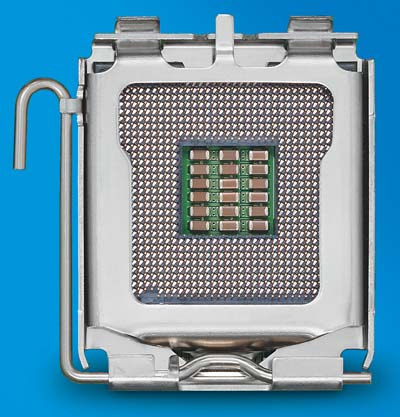
The new chipsets for Socket 775 range from the 925X at the top to a full range of mainstream 915 chipsets, both with and without the new Intel Integrated DirectX 9 graphics.
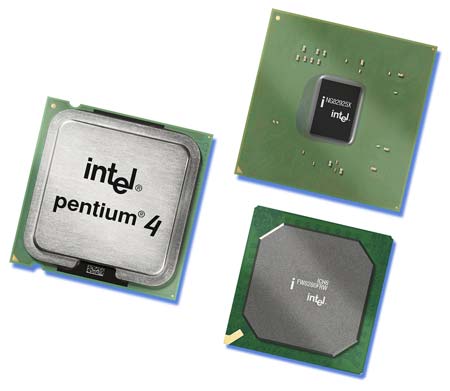
The 915/925X are updates to the current 865/875 chipsets, which will continue in the Intel line for the time being.
All of the new 775 chipsets are paired with the updated ICH6 Southbridge. The ICH6 integrates the new 24-bit 192kHz High-Definition Audio. Intel HD audio also features eight independent DMA audio engines. This can enable multiple separate, simultaneous audio streams.
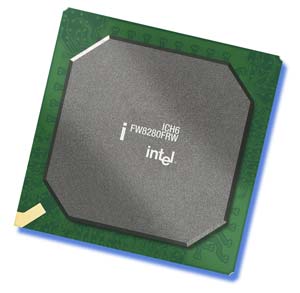
The new Southbridge also supports four SATA ports, which double the available SATA ports from ICH5. The new SATA ports can support either hard drives or optical devices with hot plug capabilities and Native Command Queuing (NCQ). While the SATA support is still SATA 1 (150MB/s), Intel claims that the new NCQ feature allows faster boots and increases file transfer speeds.
As we first saw on 875/865 family, there is also an ICH6R that can be paired with the new Northbridge chips to provide Intel Matrix RAID capabilities. The new Matrix Raid supports RAID 0, 1, 0+1, and an interesting option that allows combining both mirroring for security and striping for speed using only two drives.
New for 925X/915 is a new "W" Southbridge for ICH6 that supports Intel Wireless Connect Technology. This is designed to simplify wireless networks and connections. The W option is available with the regular Southbridge as ICH6W, and with the Matrix RAID version, ICH6RW. Consider the "W" in ICH6W and ICH6RW a future feature, however, because Intel does not yet have the wireless feature working. The accessory cards for wireless are not available at launch either.
The new Intel chipsets only support one IDE controller, so two IDE devices on the same channel is the only option for IDE. With SATA optical drives only just starting to appear, that means your IDE hard drive and optical IDE device will have to share a single channel. Even if you have SATA drives, your two IDE optical devices will have to share a single IDE channel. It is abundantly clear that Intel is trying to accelerate the move to SATA by limiting IDE options on the new chipsets.
Chipset Feature Comparison
With all of the new chipset options and features, a scorecard might help to understand the new 925X/915 chipsets and supported options.| 1 Adaptive Synchronization aligns to the closest FSB to memory clock ratio, setting memory channel to 320 MHz. 2 Does not support Pentium® 4 or Celeron® processors with a .18µ core. 3 ICH5R support Intel® RAID. 4 Supports only Pentium® 4 processors based on 90nm manufacturing technology 5 Hyper-Threading Technology support starting with B-step. 6 DDR 333 support starting with Bstep. |
If you look closely at the features, you will see that Intel High-Definition audio is available on all the new chipsets, even the value-oriented 915GV. This is only part of the story, however, since the Southbridge must be combined with an audio codec that supports all the High-Definition features. You will need to look closely at the motherboard specifications to see what audio features are actually supported by the motherboard manufacturer.
Intel's commitment to Gigabit LAN is also apparent in the across-the-board support for Gigabit LAN on the new 775 chipsets. PCI Express x16 is the only Graphics Slot supported. 4 SATA ports and one IDE channel are available on all the new 775 chipsets.
Much good and bad has been reported about Intel's use of DDR2 with the new 925X/915 chipset. Intel is apparently hedging their bets on DDR2, since you will see that DDR2 is only required for the top-end 925X. All of the 915 chipsets can support either DDR or DDR2, depending on what the motherboard manufacturer chooses to support. There are even a few dual-memory socket 775 boards, like the Gigabyte that we use later in the review to compare the performance of DDR and DDR2 memory. Intel is clearly supporting DDR2 on the Intel 915 board that we are testing, but most 3rd party manufacturers appear to be supporting DDR on their 915 motherboards.
Intel 925X Express
The Intel D925XCV is the Enthusiast version flagship for all the new Intel technology.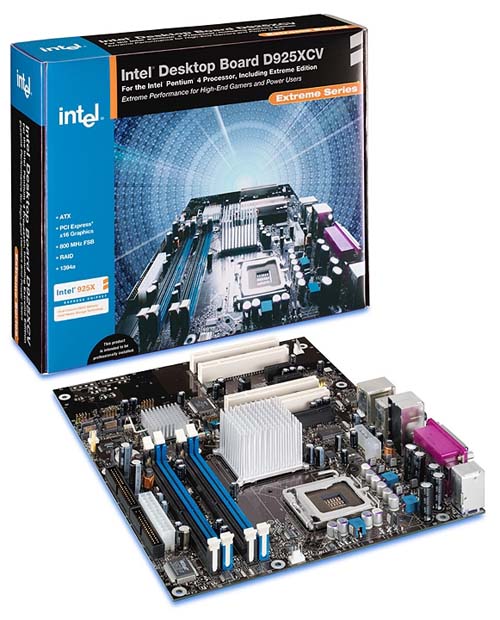
That is not to say Enthusiasts will stand in line to buy the new Intel board, since Intel has not traditionally supported the kinds of features and adjustments that will sway enthusiasts to buy a high-end Intel motherboard. The top Intel motherboard is always, however, a top-performing motherboard at default speeds, and it becomes the chipset performance standard. It is also the standard-bearer for Intel chipset features.
If you look carefully, you will see that the power connectors on the new motherboards, both 925X and 915, are 24-pin, and not the common 20-pin ATX connectors on current Pentium 4 power supplies. We found that server grade power supplies providing 24-pin connectors work fine on the new boards. However, if you have a new top-line PCIe graphics card you will likely find a new 6-pin power connector on the graphics card. You will need either a new power supply with the 6-pin graphics connector or a converter cable that allows two 4-pin molex to be combined in a 6-pin connector to power the new high-end PCIe cards. This is true of both 925X and 915 boards.
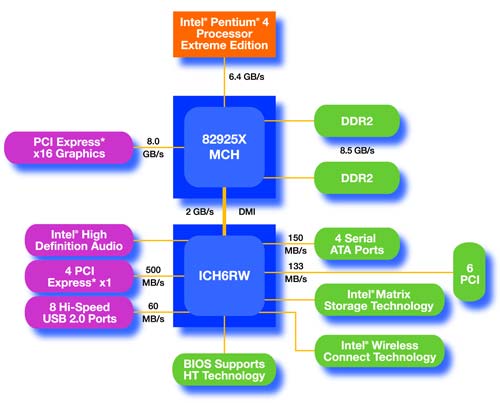
925X only supports DDR2 and PCI Express 16X graphics. 925X is also the only 775 chipset version that is stated to support ECC memory. We were not able to verify ECC support, since we did not have access to DDR2 ECC memory. The other features are related to the ICH6 version used with 925X, though you will more likely see ICH6R and ICH6RW (pictured here) paired with 925X.
The other distinguishing feature of Intel 925X is accelerated performance modes compared to 915 chipsets. Intel first differentiated their "Enthusiast" board with enhanced performance on the 875 chipset. The 875 chipset featured PAT, or Performance Acceleration Technology, which was supposed to be a unique feature of the 875 chipset. Chipset manufacturers began revising 865 boards to support PAT-like performance almost as soon as Intel launched 865/875. This was not a development that pleased Intel.
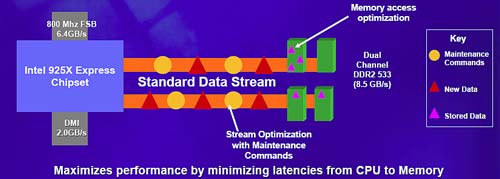
This time around, Intel is also differentiating their top chipset with enhanced performance. Intel did not share any catchy names like PAT, and the diagram above is the only information that they provided on how they make the 925X faster. When we asked for more information than the almost meaningless diagram above, Intel said their acceleration methods were "proprietary". This is not really a surprise after the PAT confusion with 875/865. Industry sources tell us that the new acceleration scheme used on 925X is much more complicated than PAT; it will not likely appear on 915 chipset solutions from other manufacturers.
Intel 915G Express
Intel also provided a D915GUX motherboard for evaluation.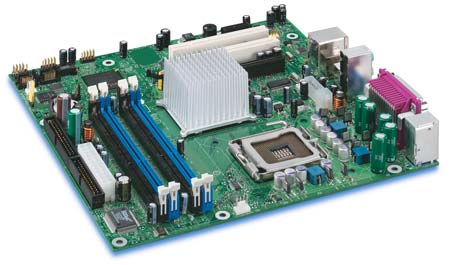
The 915 chipset comes in several flavors, both with and without the new Intel integrated graphics.
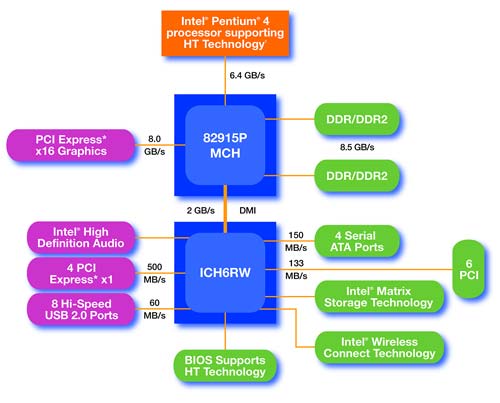
Most mainstream boards geared to AnandTech readers will feature the 915p chipset, without integrated graphics. The chipset is essentially a 925X without the acceleration technology, but with the added option of using either DDR or DDR2 memory, depending on what memory support the manufacturer chooses to provide. Other options are provided by the Southbridge and depend on which ICH6 version is paired with the 915P.
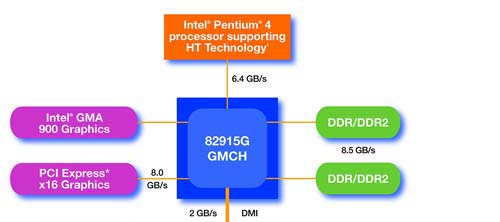
915G offers the same options as 915P, but adds Intel's integrated graphics. Intel has significantly upgraded integrated graphics for the 915 chipset, and now support DirectX 9 and OpenGL 1.4 on their integrated graphics. The new solution is called "Intel Graphics Media Accelerator 900". Intel claims that performance is doubled over Intel Intense Graphics 2. AnandTech takes a closer look at the performance of the new Intel integrated Graphics in the review of the Socket 775 CPU launch and PCIe Graphics that is the companion to this article. There is also an economy version of the 915 called 915GV, with integrated Media Accelerator 900 graphics, but without a PCIe 16X graphics card slot. We suspect that the 915GV will become a favorite of the Corporate desktop.

The D915GUX that we evaluated had all of the 915 features in a micro ATX form factor. Despite the smaller size, the D915GUX still provides integrated graphics, plus a PCIe 16X graphics slot, a PCIe 1X slot, and 2 PCI slots. All of the Intel boards, even the 915gux, provide 4 DIMM slots and support up to 4GB of memory. Please also notice that a 24-pin power connector, and not a 20-pin, is also a feature of 915 boards. 20-pin is backwards compatible, however, and the 24-pin is keyed to accept a standard 20-pin connector on one side of the new 24-pin.
Gigabyte 8GPNXP Duo
We were extremely impressed with the apparent flexibility of the dual-memory Gigabyte 8GPNXP Duo motherboard when we first saw it at Computex. With support for either a dual-channel pair of DDR2 or two dual-channel pairs of DDR, it appeared to be the perfect platform to compare DDR2 and DDR performance.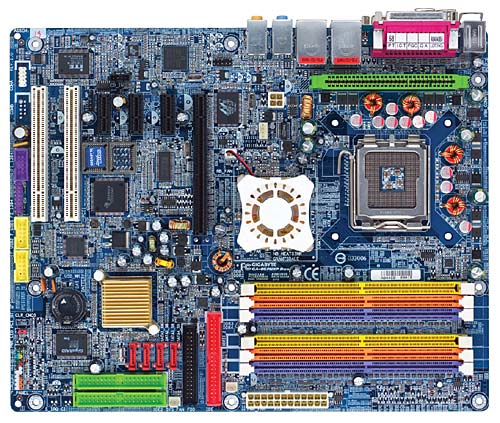
Gigabyte was kind enough to rush us a complete 8GPNXP Duo test bed for our Intel launch review, and had it here in time for testing for the chipset launch. The DUO is not a low-end board, but is a fully-featured motherboard that even includes an updated version of the trademark dual power system. This boosts the stock 4-phase power to 8-phase power to the motherboard.
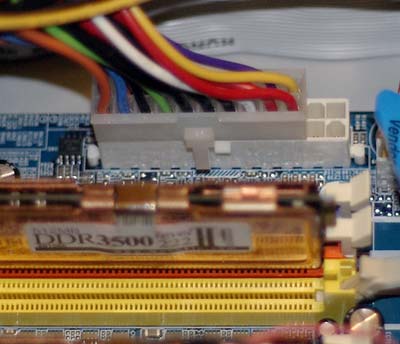
Like other socket 775 boards, the Gigabyte 8GPNXP Duo has a 24-pin power connector. We plugged a 20-pin ATX from a 350-watt power supply into the 24-pin main power connector. Intel has stated in the past that the new 24-pin is backwards compatible with current 20-pin connectors, and we verified the 24-pin is keyed to handle a 20-pin connector just fine. The modest, but decent quality, 350-watt power supply worked well in all of our tests with the Gigabyte motherboard.
Performance Test Design
With so many changes in the Intel desktop, there were a lot of burning questions to be answered. It seemed a little inadequate just to run a few benchmarks on the new chipsets, or quote performance figures supplied by Intel, so we tried to devise some comparisons that would answer the most common questions that we have heard regarding the new Intel architecture.1. How do the 925X and 915 compare in performance? Is there a significant performance difference in the new chipsets? How does the top Intel system compare to a top AMD Athlon 64 System? 925X and 915 systems were identically configured with Intel 560 processors (3.6GHz) and performance compared with a full set of motherboard benchmarks. We included benchmarks using Dual-Channel DDR memory and the same video card in an AGP 8X flavor on an AMD Athlon 64 FX53 system for comparison. These tests begin on Page 8.
2. How does Intel's new top 925X with PCIe, DDR2, and SATA Matrix RAID compare in performance to a similarly equipped top 875P system? We compared performance of a top 875 with a 3.2 Northwood, GeForce 6800 Ultra AGP 8X, SATA RAID, and DDR 2-2-2-5 memory to the Intel 925X with a 3.2E (775) Prescott, GeForce 6800 Ultra PCIe, SATA Matrix RAID, and DDR2 memory. These tests begin on Page 12.
3. Is DDR2 really faster than DDR? We verified there was no memory performance degradation of the Gigabyte Dual-Memory board compared to Intel 915. Performance with DDR and DDR2 were then compared on the Gigabyte over our motherboard test suite. These tests begin on Page 16.
925X vs. 915 vs. Athlon 64: Test Configuration
The Intel 925X and 915 were configured using the same top-end 560 (3.6GHz) CPU, 1 GB DDR2 memory, video card, hard drives, and SATA RAID Array to compare chipset performance accurately.| Performance Test Configuration | |
| Processor(s): | Intel 560 (3.6GHz) Socket 775 AMD FX53 (2.4GHz) Socket 939 |
| RAM: | 2 x 512MB Micron DDR2 533 2 x 512MB OCZ PC3200 Platinum Rev.2 (Samsung 2-2-2-5 tested at 2-2-2-10 for A64) |
| Hard Drive(s): | 2 x 250GB Maxtor MaXLine III in SATA RAID Seagate 120GB 7200RPM SATA (8Mb buffer) |
| Video AGP & IDE Chipset Drivers: | Intel Chipset Driver 6.0.0.1014 Intel Application Accelerator 4.0.0.6211 NVIDIA nForce version 4.24 |
| Video Card(s): | nVidia GeForce 6800 Ultra PCIe nVidia GeForce 6800 Ultra AGP 8X |
| Video Drivers: | nVidia 61.45 Graphics Drivers |
| Operating System(s): | Windows XP Professional SP1 |
| Power Supply: | HiPro 470W (Intel) Enermax 465W |
| Motherboards: | Intel 925XCV (Intel 925X) Socket 775 Intel 915GUX (Intel 915G) Socket 775 MSI K8N Neo2 (nForce3-250 Ultra) Socket 939 |
The AMD Athlon 64 Platform used the top-end FX53 (2.4GHz) CPU, an AGP 8X version of the same GeForce 6800 Ultra video card, 1 GB OCZ DDR400 2-2-2 DDR memory (tested at 2-2-2-10 for best A64 performance) using the new Samsung chips, and (due to time limitations) a single hard drive instead of a RAID array. Using a single drive instead of SATA RAID should place the FX53 system at a performance disadvantage.
The nVidia 6800 Ultra PCIe uses a bridge chip to the PCI Express bus. The performance impact of the nVidia 6800 Ultra bridge chip for PCIe is unknown at this point.
925X vs. 915 vs. Athlon 64: General Performance & Encoding
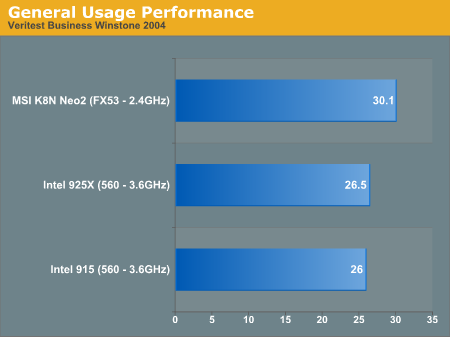
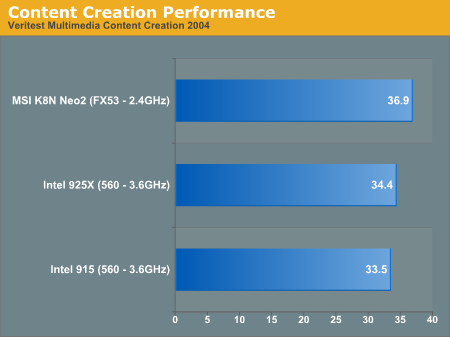
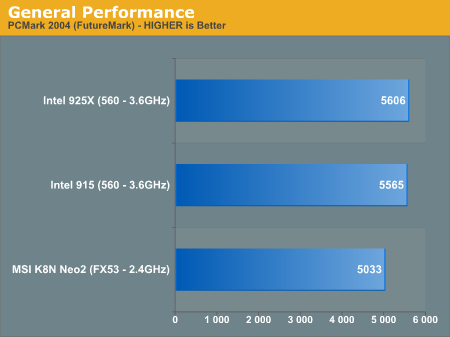
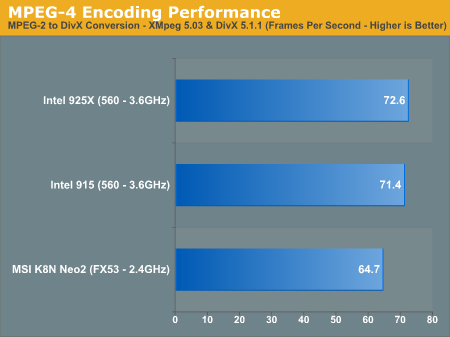
We see the 915 trailing the 925x by only about 2% to 3%, which is a much smaller performance difference than we saw with a non-PAT 865 compared to a PAT 875. We continue to see the pattern of Intel processors performing better in FutureMark Benchmarks like PCMark2004 and Sysmark 2004, and AMD Athlon 64 performing much better in Veritest Winstones. Since a significant component of PCMark 2004 is hard drive performance, the SATA RAID on the 2 Intel chipsets likely accounts for part of the performance advantage for Intel in this benchmark. Media Encoding in 32-bit has been dominated by Intel, and Intel still enjoys about a 12% performance advantage over AMD's best. However, the arrival of 64-bit encoding for AMD will dramatically change these results in the near future.
925X vs. 915 vs. Athlon 64: Gaming Performance
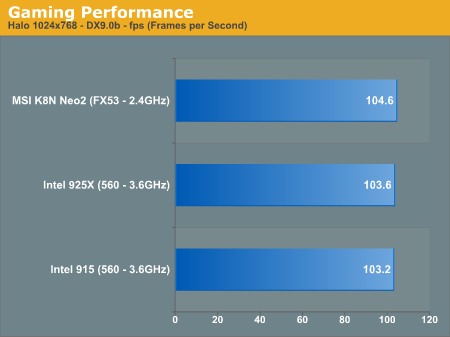

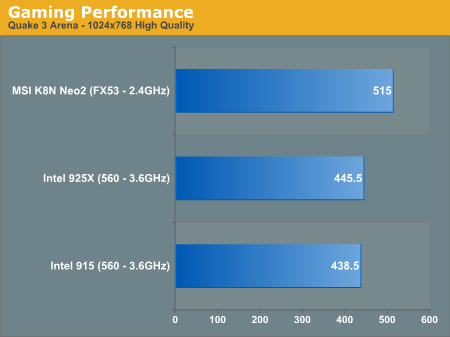
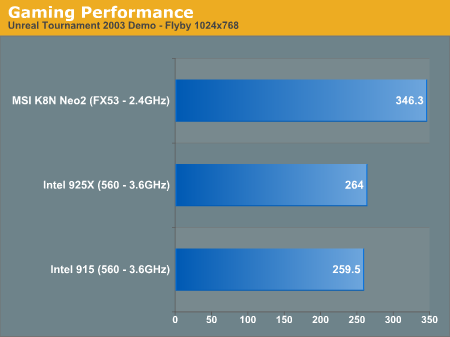
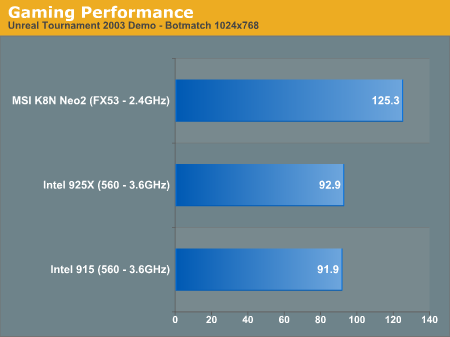


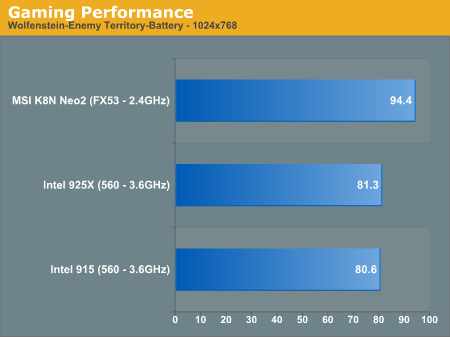

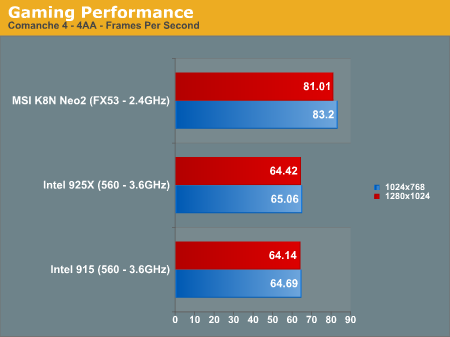
The performance difference between 915 and 925X remains very small in Gaming benchmarks. 925X is faster, but the performance advantage for 925X ranges from almost nil in DirectX 9 games like Halo to about 2% in other games. We really expected a wider difference in 925X and 915 performance. Perhaps as DDR2 memory matures and timings improve, we will begin to see a wider performance difference in the Intel chipsets.
The Gaming advantage of the FX53 here is striking. The top Athlon 64 leads in every gaming benchmark, but it completely dominates OpenGL performance in games like Quake and the more recent Return to Castle Wolfenstein. FX53 also dominates in DirectX 8.1 games like Unreal Tournament 2003. Not surprisingly, Final Fantasy XI is another game that FX53 dominates. Other Direct X 9 titles show much more competitive performance between the Intel platforms and Athlon 64. Overall, AMD's top FX53 completely dominates Intel's top 560 (3.6GHz) in most games.
925X vs. 915 vs. Athlon 64: Workstation Performance
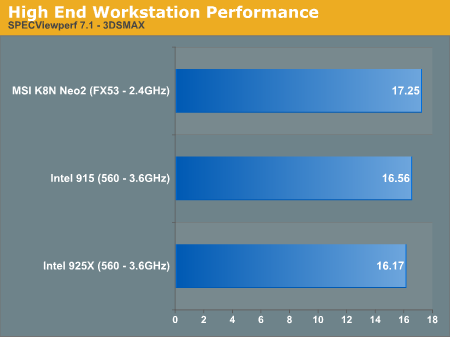

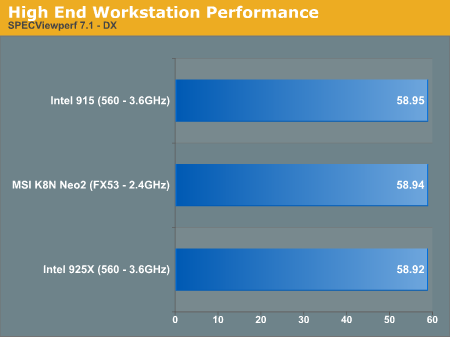
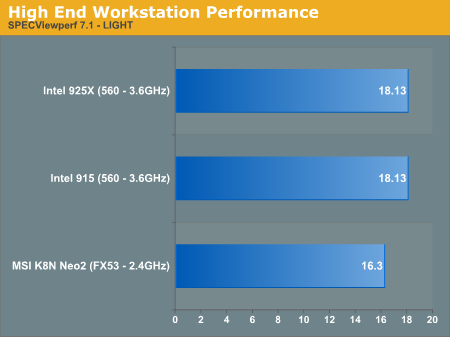
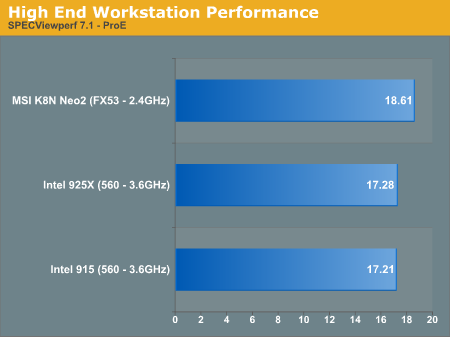
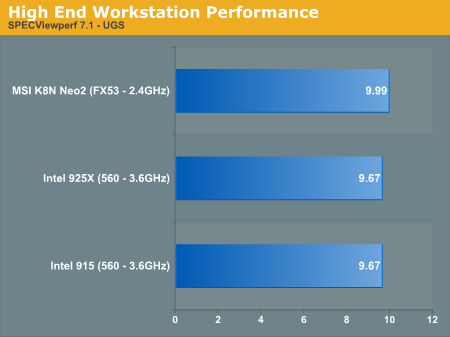
It was quite a surprise to see no advantage at all for 925X over 915 in SPECviewperf workstation tests. This is one area where the performance tweaking of 925X would be expected to stand out, but doesn't.
Across the board, there is such little performance difference between the 925X, 915, and nF3-250 Ultra that we would be hard pressed to pick one over the other.
925X vs. 875: Test Configuration
Intel claims a 2% to 7% performance advantage for the 925X over the 875 chipset. However, comparisons are with DDR400 3-3-3 memory on the 875 with both systems powered by a Prescott 3 GHz chip. A more typical high-end 875, today, would be running the faster Northwood CPU and the latest DDR400 2-2-2-5 memory available from Corsair and other vendors. For this comparison, we looked at the best of the current Intel 875 Generation compared to the best 925X that Intel is introducing today at the same 3.2GHz speed.| Performance Test Configuration | |
| Processor(s): | Intel 540 (3.2GHz) Socket 775 Intel 3.2GHz Northwood Socket 478 |
| RAM: | 2 x 512MB Micron DDR2 533 2 x 512MB Corsair 3200XL (Samsung 2-2-2-5) |
| Hard Drive(s): | 2 x 250GB Maxtor MaXLine III in SATA RAID 2 x 36.7 Western Digital Raptor SATA RAID |
| Video AGP & IDE Chipset Drivers: | Intel Chipset Driver 6.0.0.1014 Intel Application Accelerator 4.0.0.6211 |
| Video Card(s): | nVidia GeForce 6800 Ultra PCIe nVidia GeForce 6800 Ultra AGP 8X |
| Video Drivers: | nVidia 61.45 Graphics Drivers |
| Operating System(s): | Windows XP Professional SP1 |
| Power Supply: | HiPro 470W (Intel) Vantec Stealth 470W Aluminum |
| Motherboards: | Intel 925XCV (Intel 925X) Socket 775 Asus P4C800-E (Intel 875P) Socket 478 |
As previously stated, the performance impact of the nVidia 6800 Ultra bridge chip for PCIe is unknown at this point.
925X vs. 875: General Performance & Encoding
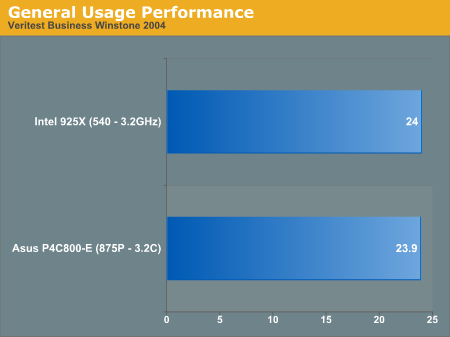

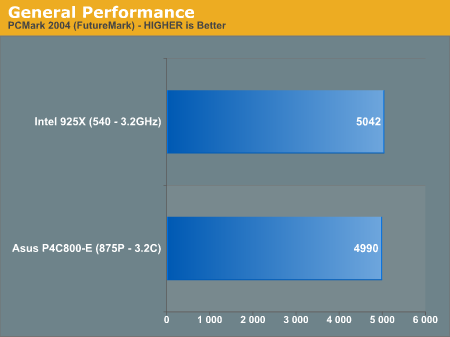
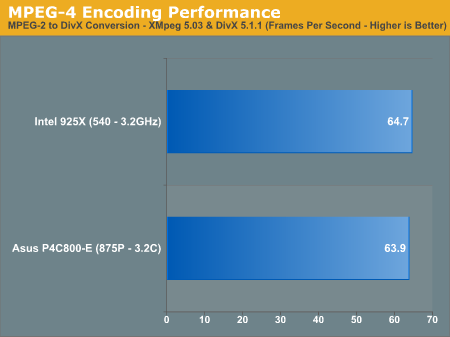
Comparing a fast current 875 system with a 3.2 Northwood to a comparable 925X with a 3.2 Prescott, Winstones, PCMark 2004, and Media Encoding all show only about a 1% performance advantage to the 925X with all the new technology.
925X vs. 875: Gaming Performance
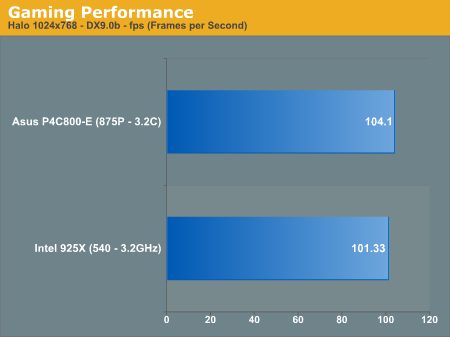
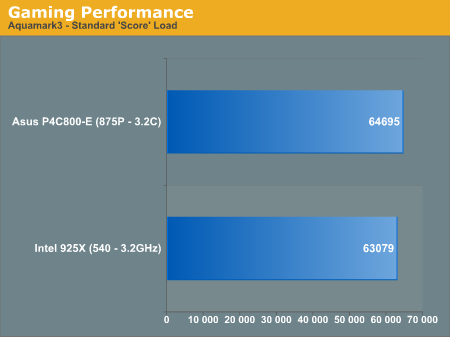
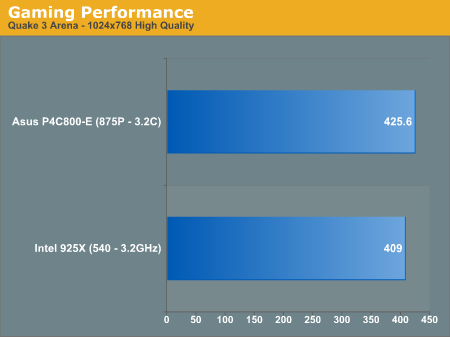
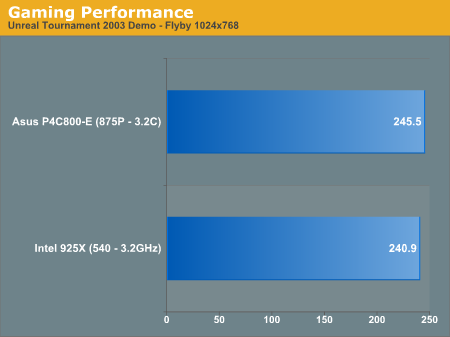
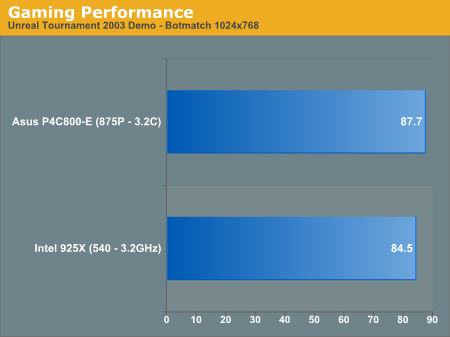
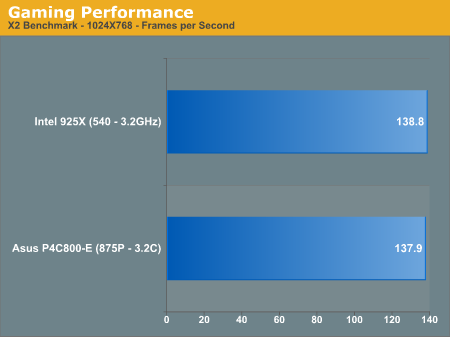
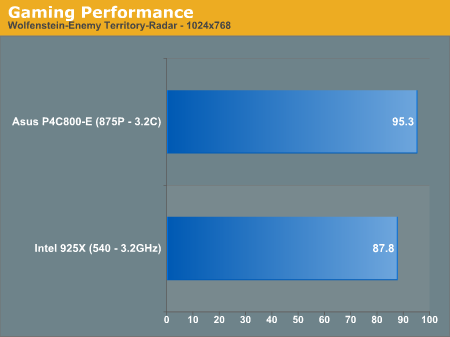
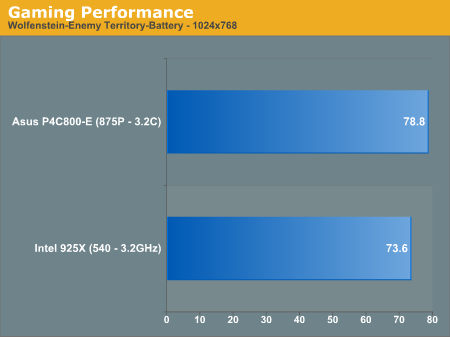

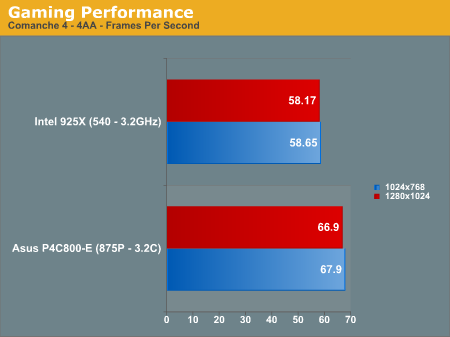
Comparing an 875 Northwood system to the new 925X, we once again see Northwood providing better gaming performance despite having only half the cache of Prescott. In virtually every gaming benchmark, the 875 Northwood is faster, ranging from 1% to 15%. Overall, Northwood averages about 5% faster gaming performance at the same speed.
This is offset by the fact that 3.4 is the fastest Northwood that you can buy. There is not a 3.6 Northwood, only the 560 Prescott in Socket 775 at 3.6GHz. As new speed grades are introduced, there will be fewer reasons to hold onto Northwood chips, but for gaming, Northwood is still a better performer at the same clock speed.
925X vs. 875: Workstation Performance
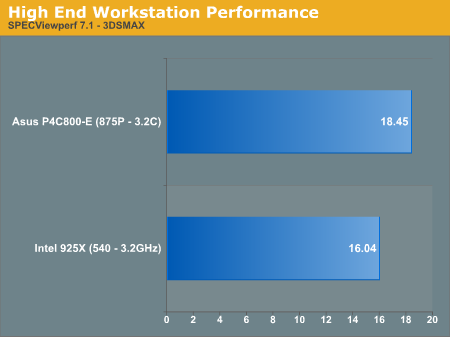
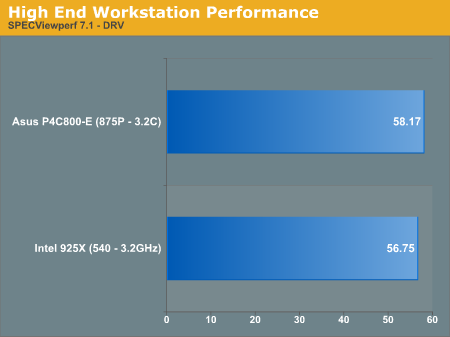
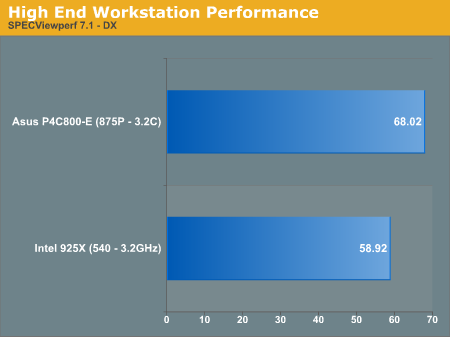
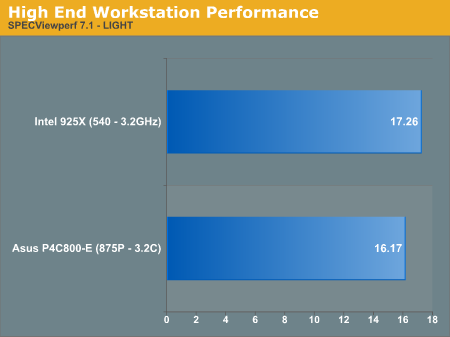
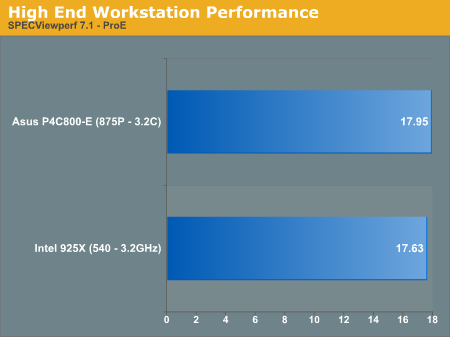

The 875 system with a 3.2C is a better performer in SPECviewperf workstation performance than the 925X with the same speed CPU. Prescott in an 875 board would likely be slower than Prescott in 925X, but the new 925X chipset still cannot completely offset the performance advantage that the C chips hold over the Prescott E processors at the same CPU speed.
DDR2 vs. DDR: Test Configuration
While the 925x/875 benchmarks indirectly compared DDR and DDR2, the Gigabyte 8GPNXP Duo is potentially the perfect platform for directly comparing DDR2 and DDR performance. It is an Intel 915 Socket 775 board that supports both types of memory in a dual channel configuration. First, we took a closer look to see if this design provided any performance penalty in providing support for either DDR or DDR2. One easy, but effective, way to check memory performance among boards is with a utility called "Aida 32", available as freeware from many download sites. Aida 32 has a unique memory test that measures separately read and write memory operations and then provides a composite score.Aida 32 results were compared on all the motherboards used in these benchmarks.
| Aida 32 Memory Test Results | |||
| Memory Motherboard |
Read MB/sec |
Write MB/sec |
Composite Score |
| Micron DDR2 533 Intel 925X |
5277 | 2219 | 7496 |
| Micron DDR2 533 Intel 915X |
5019 | 1898 | 6917 |
| Micron DDR2 533 Gigabyte 8GPNXP Duo |
5683 | 2087 | 7780 |
| OCZ 3200 Platinum R2 Asus P4C800-E |
4700 | 1861 | 6561 |
| OCZ 3200 Platinum R2 Gigabyte 8GPNXP Duo |
5440 | 1981 | 7421 |
It appears that the Gigabyte actually has faster DDR2 performance than either Intel motherboard. While this is very interesting and worth exploring in our future 915 roundup, it is not really important for this DDR2 and DDR comparison. The Aida 32 results clearly show that the DDR2 performance on the Gigabyte is not penalized by the dual-memory design.
Another very interesting test result, and totally unexpected, was that DDR memory actually performed faster on the Gigabyte 915 than on the Asus P4C800-E, which is noted for its very fast memory performance. This is something worth exploring in the future because it may mean 915 boards will run DDR faster than current 875/865 boards. One result is not enough to draw a conclusion, but we will explore this further in our upcoming Intel 915 motherboard roundup.
The Aida 32 results certainly indicate that the Gigabyte Duo is a valid platform for comparing DDR2 and DDR performance on the Intel 915 platform.
| Performance Test Configuration | |
| Processor(s): | Intel 540 (3.2GHz) Socket 775 |
| RAM: | 2 x 512MB Micron DDR2 533 2 x 512MB OCZ 3200XL DDR (Samsung 2-2-2-5) |
| Hard Drive(s): | Seagate 120GB 7200RPM SATA (8Mb buffer) |
| Video AGP & IDE Chipset Drivers: | Intel Chipset Driver 6.0.0.1014 |
| Video Card(s): | Gigabyte nVidia 5759 PCX |
| Video Drivers: | nVidia 61.45 Graphics Drivers |
| Operating System(s): | Windows XP Professional SP1 |
| Power Supply: | Powmax 350W |
| Motherboards: | Gigabyte 8GPNXP Duo (Intel 915X) Socket 775 |
Since comparisons of DDR and DDR2 were on the same platform with identical components, the system was configured as you might purchase a mid-range Intel 915 system. Graphics are provided by a mid-range nVidia 5750 PCIe graphics card with no need for auxiliary power, the CPU is a mid-range 3.2, and the power supply is a very common 350-watt with a 20-pin ATX connector attached to the 24-pin power socket. Our goal here is to compare 915 DDR to 915 DDR2, but the test results also provide a picture of typical performance that you can expect with a mid-range 915 system.
DDR2 vs. DDR: General Performance & Encoding
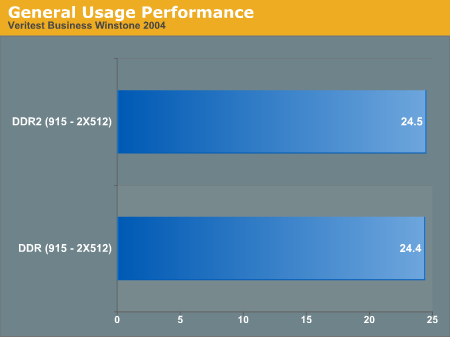
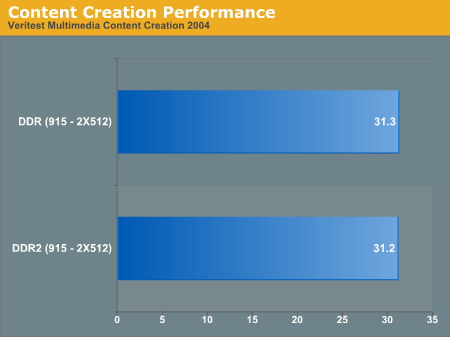
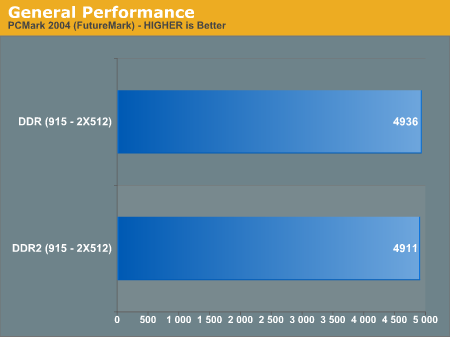
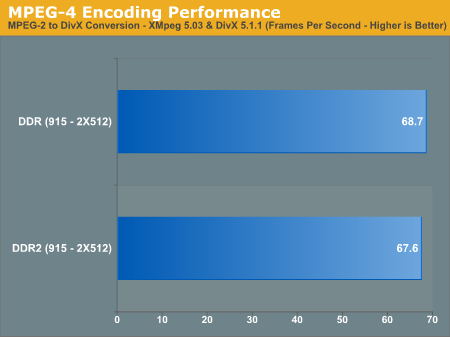
It appears that you really will not lose any performance in choosing a 915 motherboard with DDR support instead of 915 with DDR2. With initial launch prices of DDR2 still considerably higher than DDR prices, you can choose a 915 board with DDR and not have to worry about losing any performance.
As prices for DDR2 drop more in line with DDR, the choice becomes a little more interesting. DDR2 will mature beyond the current 4-4-4 timings, and as timings and headroom improve, DDR2 becomes a more interesting choice for memory.
DDR2 vs. DDR: Gaming Performance


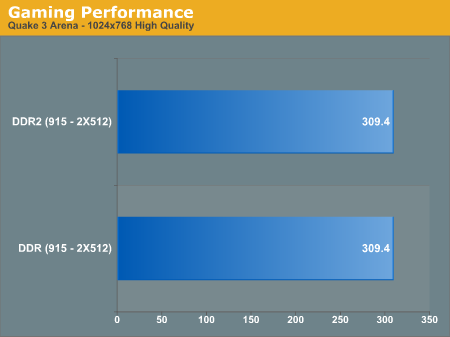
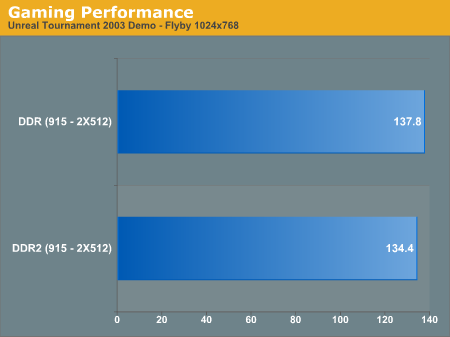
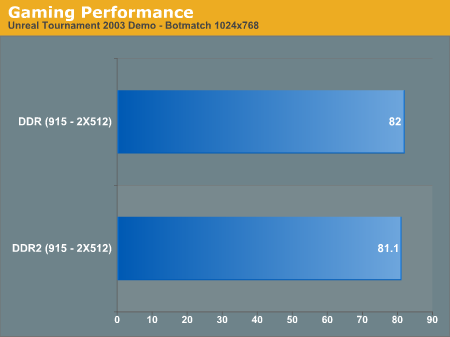

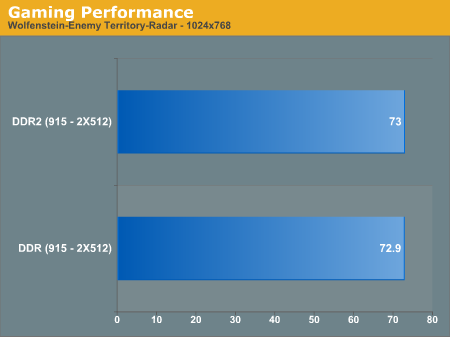


The same pattern exists in game benchmarks comparing DDR and DDR2 on the Intel 915 chipset. There is no performance advantage at all to current DDR2 533 compared to fast DDR400 memory.
DDR2 vs. DDR: Workstation Performance
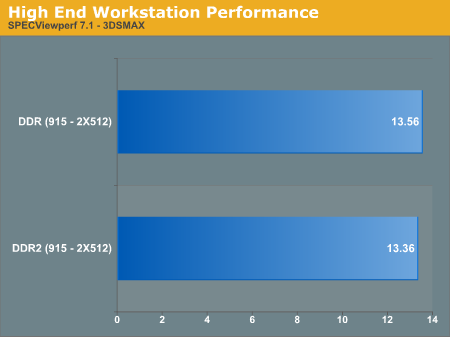
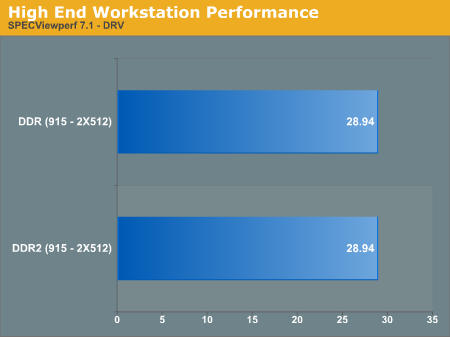
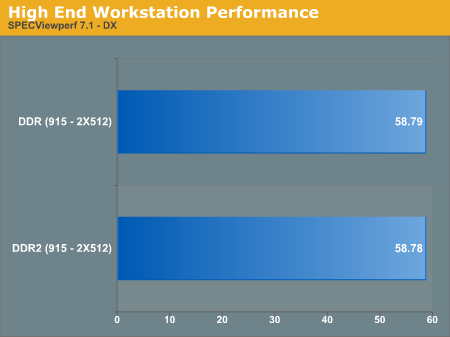
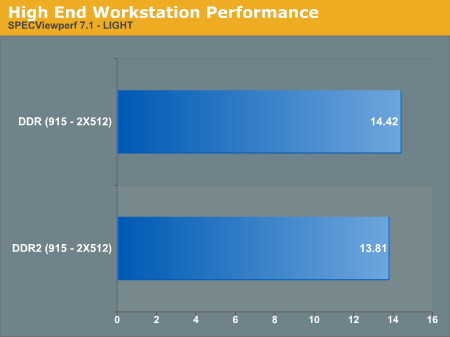

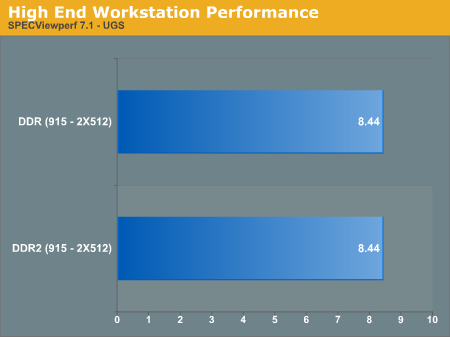
The pattern continues across Workstation Performance benchmarks. Fast DDR400 memory performs just as well as DDR2 533 on the new socket 775. Since many manufacturers are producing 915 motherboards with DDR slots, you can choose one of these boards with no real performance penalty and some good savings over DDR2 prices. As DDR2 appears with faster timings and lower prices, it will become a more attractive choice for the 915 platform.
Final Words
It was hard to resist being glib and titling this article, "Much Ado about Very Little". That feeling of disappointment comes from seeing so much new technology introduced all at once, and then finding out the real performance benefit is extremely small - if it exists at all. If Intel wants us to turn our computer world upside down, there should be a real tangible benefit to the bucks we are expected to spend. Unfortunately, that performance advantage is pretty hard to find - at least for now. There are certainly a few gems in the total package, but if you're looking for a big performance advantage it just isn't there.The feature side of the equation is a lot easier to handle, as Intel has lavished all the features a techie could dream about on the new chipsets. High-Definition audio, Matrix RAID, a new bus with a bright future, and an 8GB per second bidirectional graphics slot are a few of those features that come to mind. Those new features do come with a price, however. You are also asked basically to give up IDE hard drives and also start the transition to SATA optical devices. This will be an easier task for some than for others.
There is also the question of future advantage. It appears that all these new technologies would set you up well for the future, but frankly, we're not absolutely sure that is the case. Time and the marketplace will answer this question better than any crystal-balling, and seeing where other manufacturers and the marketplace take these new technologies will soon provide a clearer picture of what will win - and what won't. There is no doubt that Intel wields enormous clout in the marketplace, but that clout did not make Rambus a winner for Intel. If prices for the new Intel vision of a PC are high and performance gains remain small, directions can change quickly again.
There were a few real surprises in the new boards and chipsets. The 925X is the Enthusiast part, and it is clearly the fastest of the new chipsets. We were surprised, however, to find the advantage over the mainstream 915 chipset was only 1% to 3%. 925X also must use DDR2 memory, which can make that 1% to 3% performance advantage very costly at current DDR2 prices. 915 will come from some vendors with DDR2, but there will also be a huge selection of DDR 915 boards, at least until DDR2 prices drop to more comparable levels with DDR.
We also clearly saw in our performance tests that a current Intel 875 motherboard, running fast DDR memory and a Northwood processor, was just as fast as a 925X running a Prescott at the same speed. This is not really a failing on the part of the new chipsets, though, as it indicates real progress in Prescott development. When Prescott was first introduced, it was a much poorer performer than Northwood. The fact that it is now competitive with Northwood using all these new technologies indicates a lot of progress has been made.
Last, we looked at DDR and DDR2 on the 915 chipset. We saw that DDR is just as fast as DDR2 on the 915 boards, given the current state of DDR2. If you are looking for a new Intel motherboard, don't hesitate to choose a 915 with DDR support because there really isn't a performance penalty. As prices drop and timings get faster for DDR2, then DDR2 will be a better choice.
There is a lot to like in all the new features and technologies that Intel has introduced with the new chipsets. We will be covering these new features in more detail in future reviews. We just wish that there were more real performance gains to get excited about. This is nothing new for Intel, and they are a company that always seems to have plans down the road that suddenly makes it all fall into place. Be sure to read the rest of the story, which compares the new Intel processors and takes a closer look at PCIe graphics and Intel's new integrated graphics solution.

